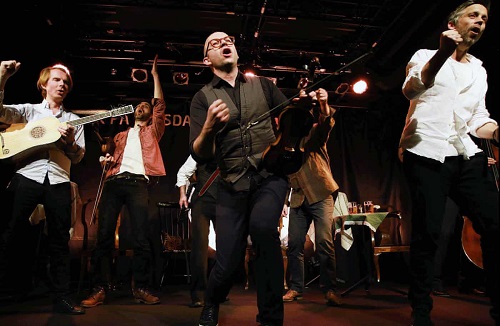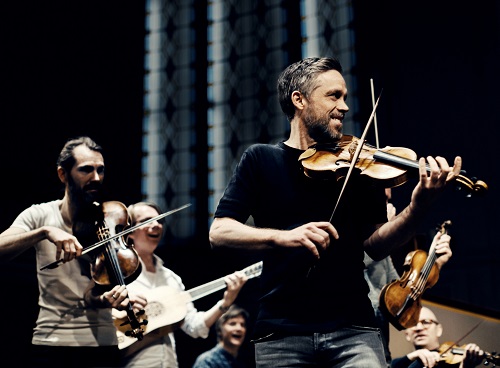In the 1980s, ‘authenticity’ was a buzzword in music research and performance; by the 1990s it was considered bothersome; nowadays it’s pretty much banished – a bygone concept of how we might approach the performance of music of bygone days.
But, if abstract academic debates about theory and practice run the risk of ‘domesticating’ music – putting it in a safe ‘drawer and bringing it out from time to time for close scholarly scrutiny – then this performance by director-singer Tom Guthrie and Barokksolistene (aka The Alehouse Boys) at Middle Temple Hall offered an authenticity of ‘experience’ that dragged music out of its box and back into the wild.
Barokksolistene’s Alehouse Sessions – curated and devised by their fleet-fingered violinist-leader Bjarte Eike – are a journey into the taverns and pubs of Cromwellian England, where actors and musicians took refuge after an Act of Parliament closed England’s theatres in 1642, at the start of the Civil War. Ostensibly, the reason behind the ordinance was that it was ‘unseemly’ to attend the theatre in such turbulent times; in truth, playhouses were considered hothouses of Royalist plotting, so the Puritans shut them down to silence the scheming. Shortly after, violations of the order led Cromwell to crack down harder – as guitarist Steve Player explained to us, with a gravelly stage-villain rasp: thespians were declared “rogues and vagabonds”, any found exercising their vocation were to be whipped, and those found enjoying a performance were to be fined five shillings. But, the show must go on. So, some of the nobility stage clandestine performances in their private homes, but most of the unemployed entertainers simply transferred themselves to alehouses which, along with theatres and brothels, formed an unholy trinity of disreputable places in Puritan eyes.

Interweaving Purcellian airs, ditties from Playford’s The Dancing Master, English sea shanties – and throwing in some Scandinavian folksong for good measure – Barokksolistene’s Alehouse Sessions spin an evolving web of song and stories. With the carefree casualness that can only come from discipline and skill, they pluck melodies from memory and toss the tunes between them, tumbling through catches, crooning through ballads. They can U-turn from wild cavorting to a whispered melodic strain with mesmerising mutability, and – as they swig from the ale-bottles perched on barrels and behind bar-chairs – there’s a mood of inebriated camaraderie that could just as easily morph into tears or a tussle.
Each performer takes a turn in the spotlight. At Middle Temple Hall, Player’s fancy footwork was as flashy as his Baldrick-inspired gallop on a ‘guitar-horse’ was droll. In the ‘Spanish Set’ (so-called, Eike told us, because it contains three English dances), Fredrik Bock’s stunning guitar solo made us hold our breath – even his impatient fellow-taverners were momentarily stilled. Violist Per Buhre’s beautifully tender rendition of ‘My Love is Like a Red Red Rose’ touched hearts. Violinist Milos Valent brought some raw Slovak rusticity into the mix, while the sounds were softened by the cushioning squeeze of Hans Knut Sveen’s Indian harmonium. Double bassist Johannes Lundberg pulled on the reins when the boys’ banter got a bit too boisterous. It wasn’t all lads being laddish, though: cellist Judith-Maria Blomsterberg added some depth to the string texture – but she decided (probably wisely) to sit out the slow-motion mime-brawl.
In 1660, the return of Charles II from exile in France restored the Stuart monarchy. And, from the Hall’s west wall, three Stuart Kings looked down upon us; presumably they would have approved of the antics. In 1672, John Banister launched public concerts ‘in alehouse fashion’ using moonlighting court musicians. Entrance cost a shilling – the same as the cheapest theatre ticket at the time – and, Roger North tells us, you could ‘call for what [tunes] you pleased’. This sort of spontaneity and interaction – whether it’s on stage between the players or between the audience and performers – is the hallmark, indeed raison d’être, of an Alehouse Session. On this occasion, being raised on a platform restricted the musicians’ sallies into the aisles, but violinist-vocalist Tom Guthrie drew some lusty refrains from the audience-chorus, and a boisterous rendition of the Scots ballad, ‘The Raggle Taggle Gypsies’, ended with soprano Mary Bevan being pulled onto the stage to deliver a meltingly beautiful melody.
Alehouse Sessions are by nature a collective experience, but the vivacity and virtuosity springs from the creative tap of Eike himself. Judging the pacing and passions of the sets perfectly, he let the musical temperature rise and fall with hypnotic fluency, playing by turns with vigorous intensity and slender delicacy. His alchemical musical sparks drew everyone in Middle Temple Hall into the musical experience.

The evening had begun with a different type of musical storytelling, but one that was similarly concerned with the social experience of music. In April 2020, I spoke to Tom Guthrie about his Schubert 200 project, in which Music and Theatre for All, of which Guthrie is director, are exploring Schubert’s song cycles on their 200th anniversaries. Beginning with Die schöne Müllerin, Guthrie’s aim is to push aside the practice of performing the song-cycles in their entirety and in a concert hall – a ‘tradition’ which grew from the pioneering performances by the baritone Julius Stockhausen (1826–1906), who gave the first complete performance of Die schöne Müllerin in Vienna’s Musikverein on 4th May 1856 – and to create an experience more akin to the world in which the songs were first performed and heard. And, this world – the early nineteenth-century salon in which social and artistic endeavours and experiences were fused – has also led Guthrie to reflect on the genesis and implications of Die schöne Müllerin.
For, the series of poems by Wilhelm Müller which Schubert sets in his 1823 cycle began life in 1817 in a form which intertwined life and art – as a Liederspiel, performed in the salon of Elizabeth Stägemann, with Müller playing the lovelorn young miller (a familiar figure from German legend and folktale) to Clemens Brentano’s hunter, his rival for the affections of the maiden, Luise Hensel (both fellow poets). Many members of the salon contributed to the Liederspiel which was essentially a set of ‘mill songs’ rather than a complete ‘narrative’. When Müller published the poems in 1820, he included a prologue and epilogue which ironically position the tale within the tradition of fictional romance.
So, Guthrie has devised a performance, similarly framed (with what are rather twee tetrameter couplets), in which the miller lad is embodied by a puppet, manipulated by Sean Garrett and Guthrie himself. Guthrie also sings the songs, with interpolated rhymed narration by Rhiannon Harper Rafferty. Taking a cue from Schubert’s practice of accompanying himself on a guitar when a piano was not to hand, Guthrie and Barokksolistene have arranged the songs – ‘a selection’ the programme suggested, but all were present, though perhaps not in their entirety – for an ensemble of five strings and two guitars. The stage was overhung by a suspended branch, intimating the rural setting (unfortunately, for those on the right of the hall, the ‘tree’ occluded the surtitles that were projected onto the back curtain).
This isn’t the first time that Guthrie has ‘staged’ Die schöne Müllerin in this way, but in 2014 Robert Murray was the singer-puppeteer and I couldn’t help feeling that Guthrie might have been wiser to adopt a more objective stance, as director (or rather, co-director since Laura Caldow and Patrick Dickie were also credited), rather than attempting to creatively multi-task. His baritone was engaging, if not always technically comfortable; but, inevitably, the varied and simultaneous demands meant that Guthrie couldn’t give attention to the vocal and musical details by which Schubert’s settings – far more poetically and musically sophisticated than that original Liederspiel – create a musical immediacy. The sparseness of the texture, with some songs being accompanied by Runar Kjeldsberg’s guitar alone, at times enhanced the pathos conjured by the puppet’s gestures and expression, but the occasional hollowness of the dry, pizzicato timbres and rustling soundscapes didn’t give Guthrie’s baritone much support. Registral shifts were a bit jarring at times.
There are places in the cycle where we hear the voice of the older miller and his daughter, and of course, at the end, the stream speaks directly. Guthrie sometimes stepped out of his role as puppeteer and addressed ‘his self’, as it were, like a literary narrator adopting a second-person stance to address his first-person protagonist. What with the striving to constantly animate a figure even when the young lad is just gazing aloft at the moon, it all felt rather hyperactive. In a recent article, Guthrie suggests that puppets ‘facilitate listening’: on this occasion I found that the puppetry hindered my engagement with Schubert’s music. He remarks, too, ‘They also, famously, die brilliantly. You just walk away from them (which will come in handy for the end of our story).’ If only Guthrie had heeded his own words! For, in ‘The Stream’s Lullaby’ the puppet was held high and hung gauntly – a poignant image – but was then passed between those on stage and the distracting ‘business’ didn’t really evoke a lulling to eternal sleep by lapping waters. Moreover, the stream should surely have the last word, as it guides our eyes up towards the moon and the sky, “… how wide it is …”. The spoken Epilogue, advising us – “if there’s someone who loves you, and you know it,/ And if they’re waiting still for you to show it/ To the miller’s memory be true/ And do as your heart has told you to” – made for a bathetic close.
Reading my words, I think I’m giving too harsh an impression. As always, Guthrie’s ideas provoked thoughts and responses, and it was a rewarding venture and experience, but one which perhaps felt like a ‘work-in-progress’. There are two more years to go until Die schöne Müllerin’s 200th birthday, so perhaps the conception will grow and be refined. In the meantime, the event was recorded and will be broadcast – a sans-puppet rendition, inevitably – on BBC Radio 3 on Wednesday 24th November 2021.
Claire Seymour
Schubert – Die schöne Müllerin: Tom Guthrie (baritone), Tom Guthrie/Laura Caldow/Patrick Dickie (directors), Ruth Paton (designer), Mandarava Butlin (puppet design and make)
The Alehouse Sessions: Barokksolistene, Bjarte Eike (director)
Middle Temple Hall, London; Thursday 18th November 2021.
ABOVE: The Alehouse Boys. Photograph: Knut Utler.